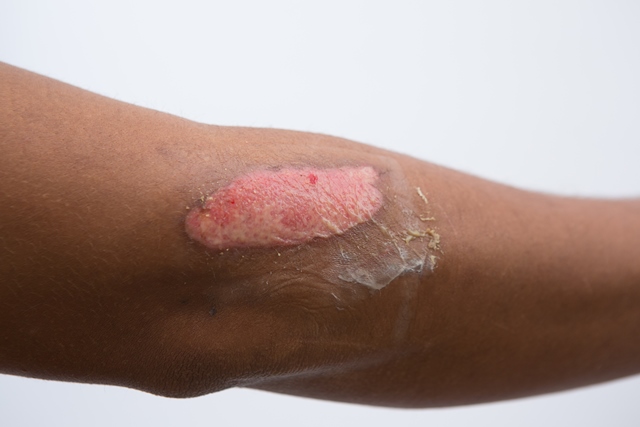
This type of accident is most often domestic, occurring in the kitchen or in the garden especially. In almost half of cases, burns are caused by contact with a hot liquid, fire or hot object. However, explosions, chemical burns and exposure to light or radiation are a lot less common. The arm is the part of the human body the most often affected, followed by the head and the leg. Burns can also lead to functional, aesthetic and psychological effects, and even infection if there is significant skin loss. Burns affect the hands in one out of two cases.
What is a burn?
A burn is above all a skin lesion which sometimes affects underlying tissue. There are four types:
- Thermal, it occurs ffurther to contact with a solid (embers, hot iron, oven etc.), liquid (boiling water/oil/burning hydrocarbon) or an explosion. The skin is thus partially or fully destroyed. However, biting cold can also cause burns.
- Chemical, caused by a caustic product (example: acid).
- Electrical, caused by contact with an electric current or arc.
- Radiation, essentially solar ultraviolet radiation and x-ray or nuclear radiation.
How is the severity of a burn evaluated ?
The severity of the skin burn3 depends on three main criteria: it’s depth, it’s extent over the body and its location.
– How is the depth evaluated ?

We use the term degrees to describe the appearance of the skin and its lesions.
- First-degree burn: highly pronounced redness causing moderate pain and only affecting the superficial layer of the skin. The skin is intact elsewhere. A typical example is sunburn.
- Superficial second-degree burn: appearance of blisters containing clear fluid, a sign that the epidermis is almost fully destroyed. The wound is red and painful.
- Deep second-degree burn: multiple blisters appear immediately. However there is less pain, as the nerve endings are destroyed. The wound is whitish pink.
- Third-degree burn: brown, white or black in colour, it is painless. The epidermis and the dermis are fully destroyed.
– How is the extent of a burn evaluated?
It is estimated as a percentage body surface area. It can also be calculated using the palm of the hand which represents 1% of the body surface area.
– Location
Some areas are to be taken particularly seriously especially the face, hands, feet and the perineum.
Other factors are also to be taken into account such as the person’s age (children under 5 or adults over 60) and also whether the person is suffering from a chronic disease (heart failure, respiratory failure, or diabetes for example).
If the burn exhibits one of these severity criteria, dial 15 or 112.
How should a burn be treated?
A burn is skin damage. It’s initial local treatment aims to restore the cutaneous tissue and should attempt to minimise any potential after-effects.
Even if first-degree burns heal spontaneously (after peeling slightly), second- and third-degree burns will need specific treatment which can only be dispensed by a healthcare professional.
– First thing to do
Before doing anything, the first thing you should do in the event of a thermal or chemical burn is to place the affected area under a stream of water (ambient temperature) for 5 to 10 minutes. This will prevent the heat from travelling to the deeper layers, will remove the residues of the chemical product (in the event of a chemical burn), and will reduce swelling and soothe the pain.
If the person’s clothing is covering the affected area, do not remove it under any circumstances. This carries the risk of detaching the skin if it is stuck. It should be noted that a serious burn can cause hypothermia (shivering) since the skin barrier no longer plays its protective role.
– Creating an environment propitious to healing
A second-degree burn requires a non adherent dressing to promote healing. This protection also prevents the risk of infection.
In effect, keeping the wound moist can guarantee optimal healing and facilitate dressing replacement, which is necessary every 2 to 3 days.
Partial or total skin graft is indicated in the event of a third-degree burn. Therefore, deep second-degree burns and third-degree burns must be treated in a specialist centre.
As a result, healing times vary according to the degree of the burn.
- First-degree: 3 to 4 days.
- (Superficial) second-degree burn: 10 to 15 days.
- (Deep) second-degree burn: 15 to 20 days.
- Third-degree burn: long-term healing, often requiring a graft.
And afterwards?
It is then necessary to closely monitor healing.
In other words, if you see no improvement after several days, or if new symptoms appear, talk to your nurse or see a doctor.
Also, ensure the scar is not exposed to the sun for at least 6 months.

